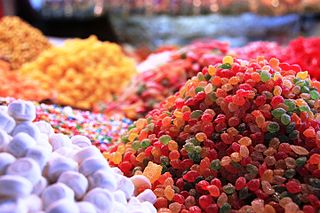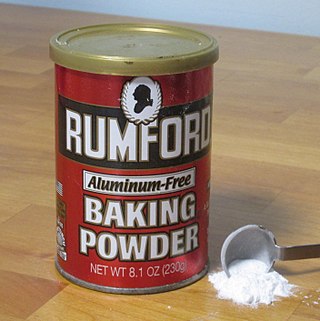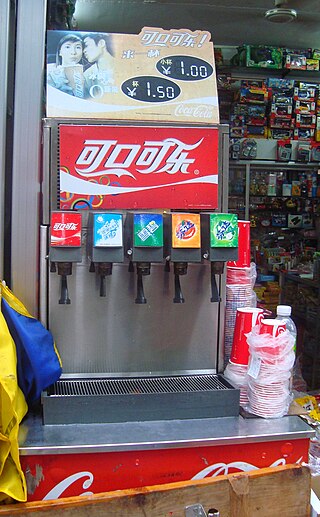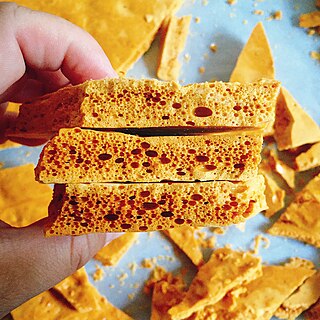
A soft drink is any water-based flavored drink, usually but not necessarily carbonated, and typically including added sweetener. Flavors used can be natural or artificial. The sweetener may be a sugar, high-fructose corn syrup, fruit juice, a sugar substitute, or some combination of these. Soft drinks may also contain caffeine, colorings, preservatives and other ingredients.

Candy, alternatively called sweets or lollies, is a confection that features sugar as a principal ingredient. The category, also called sugar confectionery, encompasses any sweet confection, including chocolate, chewing gum, and sugar candy. Vegetables, fruit, or nuts which have been glazed and coated with sugar are said to be candied.

A chocolate bar is a confection containing chocolate, which may also contain layerings or mixtures that include nuts, fruit, caramel, nougat, and wafers. A flat, easily breakable, chocolate bar is also called a tablet. In some varieties of English and food labeling standards, the term chocolate bar is reserved for bars of solid chocolate, with candy bar used for products with additional ingredients.

Baking powder is a dry chemical leavening agent, a mixture of a carbonate or bicarbonate and a weak acid. The base and acid are prevented from reacting prematurely by the inclusion of a buffer such as cornstarch. Baking powder is used to increase the volume and lighten the texture of baked goods. It works by releasing carbon dioxide gas into a batter or dough through an acid–base reaction, causing bubbles in the wet mixture to expand and thus leavening the mixture. The first single-acting baking powder was developed by food manufacturer Alfred Bird in England in 1843. The first double-acting baking powder, which releases some carbon dioxide when dampened and later releases more of the gas when heated by baking, was developed by Eben Norton Horsford in the U.S. in the 1860s.

Ginger ale is a carbonated soft drink flavoured with ginger. It is consumed on its own or used as a mixer, often with spirit-based drinks. There are two main types of ginger ale. The golden style is credited to the Irish doctor Thomas Joseph Cantrell. The dry style, a paler drink with a much milder ginger flavour, was created by Canadian John McLaughlin.

Carbonated water is water containing dissolved carbon dioxide gas, either artificially injected under pressure or occurring due to natural geological processes. Carbonation causes small bubbles to form, giving the water an effervescent quality. Common forms include sparkling natural mineral water, club soda, and commercially produced sparkling water.

A lollipop is a type of sugar candy usually consisting of hard candy mounted on a stick and intended for sucking or licking. Different informal terms are used in different places, including lolly, sucker, sticky-pop, etc. Lollipops are available in many flavors and shapes.

York Peppermint Pattie is an American dark chocolate enrobed peppermint confection introduced in 1940 and currently produced by the Hershey Company.

Mentos are a brand of packaged scotch mints or mint-flavored candies sold in many stores and vending machines. First produced in 1932, they are currently sold in more than 130 countries worldwide by the Italian-Dutch corporation Perfetti Van Melle. The mints are small oblate spheroids, with a slightly hard exterior and a soft, chewy interior.

A soda fountain is a device that dispenses carbonated soft drinks, called fountain drinks. They can be found in restaurants, concession stands and other locations such as convenience stores. The artifact combines flavored syrup or syrup concentrate and carbon dioxide with chilled and purified water to make soft drinks, either manually, or in a vending machine which is essentially an automated soda fountain that is operated using a soda gun. Today, the syrup often is pumped from a special container called a bag-in-box (BiB).

Shasta Beverages is an American soft drink manufacturer that markets a value-priced soft drink line with a wide variety of soda flavors, as well as a few drink mixers, under the brand name Shasta. The company name is derived from Mount Shasta in northern California and the associated Shasta Springs.

Honeycomb toffee, honeycomb candy, sponge toffee, cinder toffee, seafoam, or hokey pokey is a sugary toffee with a light, rigid, sponge-like texture. Its main ingredients are typically brown sugar and baking soda, sometimes with an acid such as vinegar. The baking soda and acid react to form carbon dioxide which is trapped in the highly viscous mixture. When acid is not used, thermal decomposition of the baking soda releases carbon dioxide. The sponge-like structure is formed while the sugar is liquid, then the toffee sets hard. The candy goes by a variety of names and regional variants.

Beer head is the frothy foam on top of beer and carbonated beverages which is produced by bubbles of gas, predominantly carbon dioxide, rising to the surface. The elements that produce the head are wort protein, yeast and hop residue. The carbon dioxide that forms the bubbles in the head is produced during fermentation as yeasts break down sugar-rich molecules to produce ethanol and carbon dioxide. The carbonation can occur before or after bottling the beer. If the beer continues fermenting in the bottle, then it naturally carbonates and the head is formed upon opening and/or pouring the beer. If the beer is pasteurized or filtered then the beer must be force carbonated using pressurized gas.

Tootsie Roll Industries is an American manufacturer of confectionery based in Chicago, Illinois. Its best-known products include the namesake Tootsie Rolls and Tootsie Pops. Tootsie Roll Industries currently markets its brands internationally in Canada, Mexico, and over 75 other countries.

A slushy is a type of beverage made of flavored ice and a drink, similar to granitas but with a more liquid composition. It is also commonly called a slush, slurpee, frozen beverage, or frozen drink. A slushie can either be carbonated or non-carbonated; the carbonated version is sometimes called a frozen carbonated drink or frozen carbonated beverage.
A soda geyser is a physical reaction between a carbonated beverage, usually Diet Coke, and Mentos mints that causes the beverage to be expelled from its container. The candies catalyze the release of gas from the beverage, which creates an eruption that pushes most of the liquid up and out of the bottle. Lee Marek and "Marek's Kid Scientists" were the first to publicly demonstrate the experiment on the Late Show with David Letterman in 1999. Steve Spangler's televised demonstration of the eruption in 2005 became popular on YouTube, launching a chain of several other Diet Coke and Mentos experiment viral videos. Experiments carried out at altitudes ranging from below sea level in Death Valley to the summit of Pikes Peak have demonstrated that the reaction works better at higher elevations.

Sherbet is a fizzy, sweet powder, usually eaten by dipping a lollipop or liquorice, using a small spoon, or licking it from a finger.

A soda machine or soda maker is a home appliance for carbonating tap water by using carbon dioxide from a pressurized cartridge. The machine is often delivered with flavorings; these can be added to the water after it is carbonated to make soda, such as orange, lemon, or cola flavours. Some brands are able to directly carbonate any cold beverage.


















